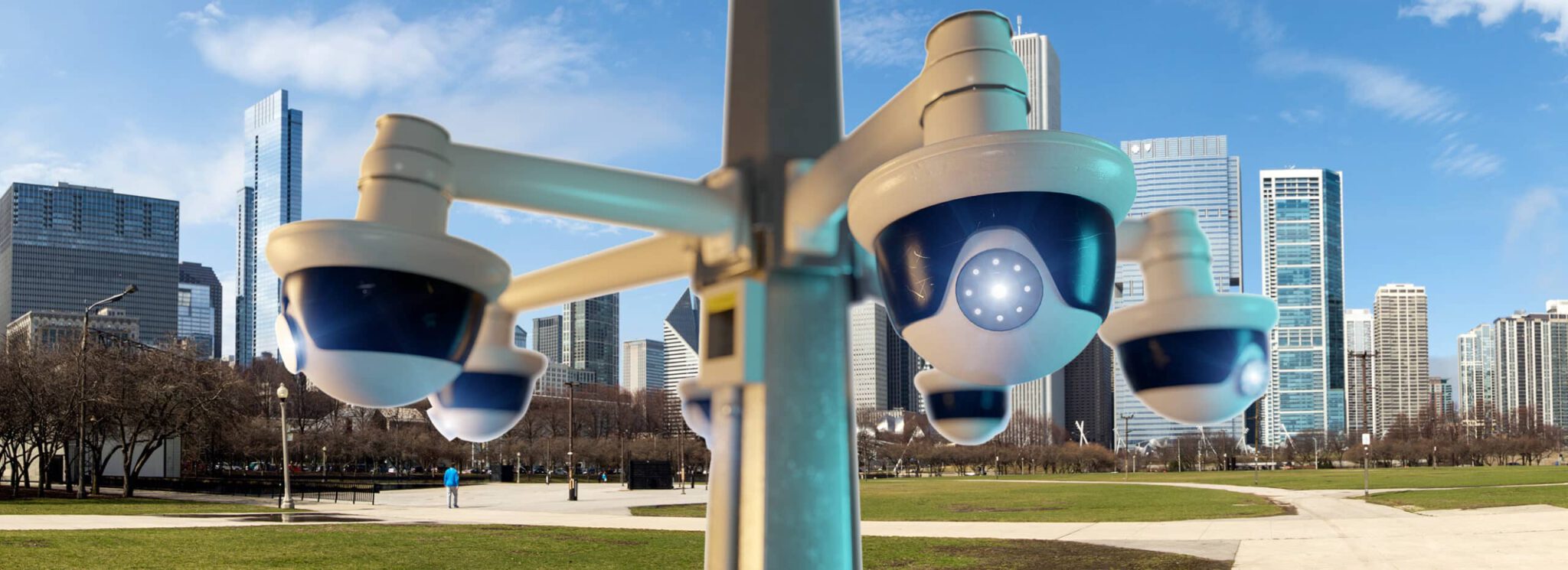You may have heard that video surveillance deters crime and helps bring criminals to justice. Can it actually do that? Or is it a marketing ploy?
Maybe the New York Times story about the East Orange police department in New Jersey will answer that.
How a Police Department Decreased Its Crime Rates
East Orange Detective Robert Harris patrols the streets from his patrol car using a dashboard computer. He pulls up live video from video surveillance cameras posted around the city.
The police department supports a population of 70,000. Unfortunately, the city’s crime rates had surpassed the national average. It reached a point where it had an average of five cars stolen every day.
Fortunately, that has recently changed for the better. The police department reports the crime rate has dropped by more than 50 percent. Burglaries, car theft, and robberies all went down by half.
What’s eye-opening about East Orange’s experience is what the city has done to make a difference. It’s not luck or an area-wide decrease in crime. In fact, crime is rising in two neighboring cities.
What did East Orange police do to drastically cut the crime rate? It’s not the size of the police force. That hasn’t changed. The biggest differentiators are video surveillance equipment and data collection. The police department paid for the technology with money seized from criminals.
How Video Surveillance Helped Other U.S. Cities
East Orange isn’t the only city to benefit from video surveillance. Chicago and Baltimore also have seen their crime numbers drop. With more city governments implementing video surveillance, the Urban Institute conducted a study on its effectiveness.
After installing cameras, Baltimore’s crime rate fell by more than an average of 30 incidents per month. Chicago credits video surveillance cameras for decreasing the crime rate by more than 12 percent. The Windy City’s violent crime is also down by 20 percent and robbery by one-third.
The study confirms monitoring is a critical piece for video surveillance. One area in Chicago saw no change to its crime rates. Its residents thought no one was watching the cameras. It’s also a reminder to those who have monitoring to post “Area under surveillance” signs.
Reducing crime rates in Chicago and Baltimore has resulted in a quick ROI for their video surveillance. Baltimore received 50 cents back for every dollar spent. Chicago’s criminal justice costs fell by $815,000 month.
You also can’t put a number on the emotional toll of victims. A person who does not become a victim does not need counseling, does not need to miss work, does not struggle to get through the day, and does not experience any of a survivor’s traumatic side effects.
Video Surveillance Cameras as a Crime Deterrent
Consider this. A University of North Carolina at Charlotte study, titled “Understanding Decisions to Burglarize from the Offender’s Perspective” surveyed more than 400 male and female burglars in jail.
The study asked how they chose targets and what stopped them from going after a target. More than half said the No. 1 factor they considered a deterrent was video surveillance cameras. Almost half said seeing cameras would prevent them from going after a target.
At the University of California Berkeley Law, Jennifer King and her colleagues have completed a six-month study of the San Francisco Community Safety Camera Program. It turns out there’s a significant decrease in property crimes in areas with video cameras present.
Arizona State University’s “How CCTV Aims to Prevent Crime” references “Modeling Offenders’ Decisions: A Framework for Research and Policy” from Crime and Justice by Clarke and Cornish. The paper shows that video surveillance systems deter crime when it contains these two elements:
- The suspect knows there are cameras present.
- The suspect thinks the risk of cameras aren’t worth the rewards of the crime.
This reinforces the need for camera visibility and signs indicating the area is under surveillance. It reassures people the cameras are there and someone is watching. If a business tries to post fake cameras and signs, it could become a liability issue. What about video surveillance? Is it a liability? Video surveillance with monitoring reduces
liability.
In summary, the prominent presence of video surveillance cameras and signs indicating the area is monitored helps deter criminals.
Factors That Impact Video Surveillance’s Effectiveness
Other factors will impact how effective a video surveillance system will be. One is the visibility of the surveillance cameras.
Make video cameras visible
Some businesses try to hide their surveillance cameras. Perhaps, it’s to make their clients and employees feel more comfortable and less like Big Brother.
The truth is that the presence of cameras makes them feel secure while scaring away the criminals. Of course, not all criminals are going to let cameras stop them. When they’re determined, intruders will keep going until they achieve their goals.
Video surveillance camera resolution
The next factor is the camera resolution. Even with all the technology available today, there are still cameras that can’t make out faces or license plate information. Businesses that want to catch suspects after they’ve left the property need that capability. Otherwise, they won’t be able to identify the suspects.
Video surveillance camera location
An often-overlooked factor is the location of the cameras. There’s a science in camera placement to maximize their benefits. Some businesses post cameras at entrances and inside, but forget about the parking lot and other areas of the property. You want to maximize your views without putting up more cameras than you need.
Audio
Many properties opt to install speakers in addition to cameras. This allows the person watching the cameras to alert the trespassers they are being watched. This is another deterrent. Again, some suspects won’t let anything stand in their way. That’s why an integrated multi-layered security system is important.
Monitoring
If intruders continue with their mission, the security operator will call the police to report the suspicious people. With the police on the way, the monitoring operator follows the suspects across cameras and in some cases, pan-tilt-zoom (PTZ) cameras, to track them and zoom in for a closer look. The operator stays in touch with the police until the police arrive and locate the prowlers.
Some businesses use video surveillance without monitoring. What’s the point of having cameras if no one is watching them? A high-quality video surveillance system uses a combination of video surveillance, video analytics, and human intelligence to enhance the effectiveness of video monitoring. It increases the chances of catching problems and decreasing false positives from harmless things like a flying plastic bag.
Night-time viewing
Crime happens 24/7. However, not all cameras have the ability to see at night. When no one is on a property outside of daytime hours, intruders may choose that time to attack. If you want clear eyes on the property around-the-clock, ask about thermal imaging or other night-time cameras.
Reliability
Businesses with a parking lot and other outdoor concerns will want to investigate the video surveillance system’s handling of extreme weather conditions. A thief may also attempt to disable the cameras. Ask about the possibility of that happening and losing the video.
Technology breaks. That’s a fact. How can you make sure your video surveillance system continues to function? That’s where system health checks
come in. It’s a proactive way to ensure video surveillance continues to do its job. It can also catch small problems before they become bigger problems.
Other factors
Businesses with a tall property or a lot of acres may benefit from long-range surveillance. For instance, an office building or apartment complex can use long-range surveillance to zoom in on vehicles in the parking lot. A construction site uses long-range surveillance to bolster perimeter security.
Time-lapse cameras are great for documenting and showing the progress of a project or property. Construction companies use it as a project management and marketing tool to share their construction project’s progress.
A suspicious vehicle may show up on the property, but the cameras cannot see the driver’s face as it’s hidden. This is where license plate recognition can help. In searching for license plate recognition cameras, ask about the accuracy level, moving vehicle speed, lighting performance, and the ability to capture non-reflective plates. It’s possible to find low light performance cameras with built-in IR.
How to Choose the Right Video Surveillance System
These are many factors to consider. As you research video surveillance systems, consider these three things:
1. Company background
How long have they been in business? Do they provide video surveillance services or do they sell other security solutions, such as security guard services? Where are their monitoring centers? How are they set up? Have they worked with companies in your industry?
2. Remote video surveillance monitoring experience
Companies with monitoring experience will have many surveillance videos showing how they deter and catch suspects. Ask about training for security operators, arrest numbers, crime deterrent numbers, and how many sites they monitor.
3. Video surveillance system services
A variety of video surveillance options are available. Some things to explore include real-time monitoring, 24/7 monitoring, voice-down, system health checks, mobile video surveillance, backup plans, and more.
The choose the right video monitoring service article contains a checklist that covers all of these areas. Video surveillance requirements vary by industry. You want to work with one that has proven experience in yours. When you pick the right video surveillance service, it can help speed your ROI. They’ll make sure you have a right-sized solution, nothing more and nothing less.
On top of it all, video surveillance systems deliver many benefits besides deterring crime. To learn more about this, check out Live Video Monitoring: More Than Just Catching Criminals. Please contact us with your questions.

